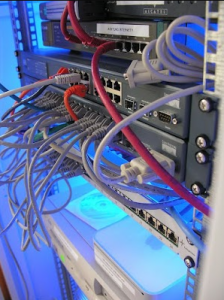
In the age of high-speed internet and smart homes, having a robust network cabling system in your home is more crucial than ever.
Whether you’re setting up a new home or upgrading your current residence, understanding the basics of residential network cabling is key to ensuring a seamless and efficient digital experience.
Let’s walk through the essentials for beginners in home network cabling.
Understanding Network Cabling
Network cabling in a residential context refers to the infrastructure that allows devices within your home to connect to the internet and to each other.
This includes cables, connectors, and distribution systems. The most common types of network cables used in homes are Ethernet cables, including Cat5e, Cat6, and the more advanced Cat6a.
Types of Network Cables
- Cat5e
This is the most basic type of Ethernet cable, suitable for most home networking needs, supporting speeds up to 1 Gbps.
- Cat6
A step up from Cat5e, Cat6 supports higher bandwidths and is ideal for networks with higher data consumption.
- Cat6a
This advanced cable is designed for extremely high-speed internet connections and is future-proof for next-generation network needs.
Planning Your Network
Before laying out any cables, it’s important to plan your network. Consider the layout of your home and where you’ll need wired internet access.
Think about the placement of your modem, router, and any switches or hubs. Remember, the shorter the cable run, the better the performance.
Installation Basics
- Running the Cables
When running cables through walls and floors, use conduits to protect them from damage. Avoid sharp bends and keep cables away from electrical wiring to prevent interference.
- Terminating the Cables
Each end of your Ethernet cable needs to be terminated with a connector, usually an RJ45. This can be a tricky process and might require a crimping tool.
- Testing Your Connections
After installation, use a cable tester to ensure each connection is working correctly.
Wireless vs. Wired
While wireless technology is convenient, a wired connection is more reliable and often faster. For activities like gaming, streaming, or transferring large files, a wired network is preferable.
Maintenance and Upgrades
Regularly check your cables and connections for wear and tear. As technology evolves, consider upgrading your cables to meet new standards and improve network performance.
Upgrade Your Home Network
If you’re looking to upgrade your home’s networking capabilities, HE Technology is your go-to expert in residential network cabling and home data cabling in Perth.
Our team of skilled professionals is dedicated to providing top-tier services to ensure your home network is efficient, reliable, and tailored to your specific needs.
Don’t let outdated cabling hold you back.
Contact HE Technology today to elevate your home connectivity experience.
Let us help you navigate the world of home data cabling with ease and expertise.
FAQs
A basic home network comprises several key components: a modem (which connects your network to the internet), a router (which connects various devices to the network and provides security), Ethernet cables for wired connections, and the devices you wish to connect. The right hardware choice depends on the number and types of devices you want to connect. The modem is the most crucial part, often provided by the ISP and sometimes integrated into the router. The router allows multiple devices to connect to the internet and to each other.
While maintaining network cabling at home can seem challenging, it becomes manageable with the right approach. Proper installation is key to effective cable management and long-term performance. Knowing how to label and organise cables helps in easy troubleshooting and maintenance. An organised system simplifies identifying and addressing any issues that might arise with the network cabling.
The cost of installing network cabling in a home varies based on the project’s complexity and scope. So it’s advisable to consider hiring a professional, as this might be more cost-effective in ensuring the job is done correctly.







